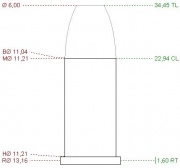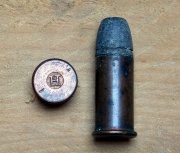.44 Henry
| .44 Henry | |||||||
|---|---|---|---|---|---|---|---|

| |||||||
| .44 Henry cartridges | |||||||
| Type | Rifle/Pistol | ||||||
| Country of Origin | USA | ||||||
| Specifications | |||||||
| Case Type | rimmed | ||||||
| Bullet Ø | .446 in (11.3 mm) | ||||||
| Neck Ø | .434 in (11.0 mm) | ||||||
| Base Ø | .441 in (11.2 mm) | ||||||
| Rim Ø | .518 in (13.2 mm) | ||||||
| Rim Thickness | .062 in (1.6 mm) | ||||||
| Case Length | .903 in (22.9 mm) | ||||||
| Full Length | 1.345 in (34.2 mm) | ||||||
| Primer | Rimfire | ||||||
| Production & Service | |||||||
| Designer | New Haven Arms Company | ||||||
| Design Date | 1860[1] | ||||||
| Ballistic Performance Sampling | |||||||
| |||||||
Contents[hide] |
[edit] Background
The cartridge is named in honor of Benjamin Tyler Henry, A 19th century American gunsmith. Henry was the foreman of the New Haven Arms Company, who had been working on a new, innovative rifle and rimfire cartridge. On October 16, 1860, Henry was granted a patent for the famous Henry Repeating Rifle. Both the cartridge and the rifle were named for Henry, its inventor[2].[edit] Ballistics
The cartridge's 200-grain bullet had a flat nose. A pointed nose was later used, with a ballistic coefficient of about 0.153, which reflects very poor long range capabilities. The .44 Henry had an arcing trajectory, making hitting a target past 200 yards almost impossible for the average shooter.[3]. Modern comparisons to the .44 Henry rifle's ballistics would include such cartridges as the 200gr .45 ACP, and 200gr .44 Special. Although these latter can nearly achieve the Henry Rifle's velocity from a handgun. The resulting effective range for military or small medium game would be well under 100 yards.
[edit] Military use
The .44 Henry cartridge was used most notably in the Henry Model 1860 Repeating rifle. This rifle was used in the American Civil War, mainly by Union troops. It was also used by the very few Confederate troops who managed to capture these rifles.
After the Civil War, the Henry cartridge was used in the Winchester Model 1866 Muskets during the Russo-Turkish War (1877-1878) by the Turkish Troops and in the Franco-Prussian War 1870/71 by the French.
In civilian models, Winchester Mod 66 rifles and carbines, Smith & Wesson No. 3 Revolvers, Colt Model 1860 Army Long Cylinder Conversions and the Colt Model 1871/72 “Open Top” used the same cartridge. From 1875 until 1880, Colt produced 1873 Colt Single Action Army revolvers in the Henry caliber to accommodate the owners of Henry- and Winchester Mod 1866 rifles and carbines.
[edit] Later Developments
The cartridge casings were originally made from copper, and later in brass. The cartridge was still commercially made into the 1930s.
The .44 Henry cartridge was perfected by George R. Stetson’s U.S. Patent 120403, assigned to the Winchester Repeating Arms Company on October 31, 1871. It has as its object the use of swaged and lubricated projectiles of greater perfection in shape.

